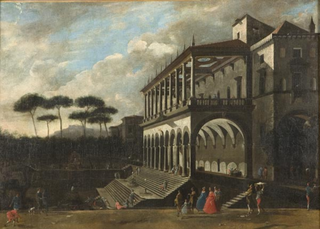
Naples is the regional capital of Campania and the third-largest city of Italy, after Rome and Milan, with a population of 909,048 within the city's administrative limits as of 2022. Its province-level municipality is the third-most populous metropolitan city in Italy with a population of 3,115,320 residents, and its metropolitan area stretches beyond the boundaries of the city wall for approximately 20 miles (32 km).

Vomero is a bustling hilltop district of metropolitan Naples, Italy — comprising approximately two square kilometres (0.77 sq mi) and a population of 48,000.

Arenella is a quarter of Naples, southern Italy. It is on the Vomero hill above the city and was, 300 meters in elevation. Many years ago was considered a place to go to "get away from it all". It is near to the main hospital section of the city, set somewhat higher, on the way up to the Hermitage of Camaldoli. It has some points of historic interest, such as the presence of the workshop of Giambattista della Porta.

Miano is a suburb of Naples, Italy, with a population of around 26,000.

The Four Days of Naples was an uprising in Naples, Italy, against Nazi German occupation forces from September 27 to September 30, 1943, immediately prior to the arrival of Allied forces in Naples on October 1 during World War II.

Line 1 is an 18.8-kilometre (11.7 mi) rapid transit line, part of the Naples Metro in Naples, Italy. As of July 2023, Line 1 connects 19 stations. It is operated by Azienda Napoletana Mobilità SpA (ANM). The line has been renamed Metrò dell'Arte reflecting the presence of contemporary art works installed in some of its stations.

The Mergellina Funicular, is one of four operating funiculars in the public transportion system of Naples, Italy. The system is a true funicular: an inclined railway with two passenger cars, connected via cables, operating in concert.

The districts of Naples are the sectors that, within the city, are identified by particular geographical and topographical, functional and historical features.

The Third Municipality is one of the ten boroughs in which the Italian city of Naples is divided.

Attilio Pratella was an Italian painter, noted for his landscapes and realistic scenes of Neapolitan life.

The historic center, or Centro Storico, of Naples, Italy represents the historic nucleus of the city, spanning 27 centuries.

The following is a timeline of the history of the city of Naples. The Naples area has been inhabited since the Neolithic period. The earliest historical sources in the area were left by the Myceneans in the 2nd millennium BC. During its long history, Naples has been captured, destroyed and attacked many times. The city has seen earthquakes, volcanic eruptions, foreign invasions and revolutions.

The Catacombs of Saint Gaudiosus are underground paleo-Christian burial sites, located in the northern area of the city of Naples.

The Petraio is a lineal urban neighborhood and pedestrian road in Naples, Italy. It descends from what was once an expansive upper agricultural area and connects adjacent neighborhoods to downtown Naples — terminating just outside the original perimeter walls of Naples, near the present day Chiaia district.

Trieste is the 17th quarter of Rome (Italy), identified by the initials Q. XVII.

Rione Alto is a district of Naples, built at the turn of the 1960s and 70s in the Arenella district, near the hospital area.

Piazza Medaglie d'Oro, in the Arenella district, is one of the main squares in the Vomero district, in the city of Naples. In the square, octagonal in shape, eight streets radiate out, including some of the main arteries of the district, making it one of the nodal points of the neapolitan urban structure, crossroads and switching point of the Fifth Municipality of Naples, which includes the two Arenella and Vomero.

The history of cinema in Naples begins at the end of the 19th century and over time it has recorded cinematographic works, production houses and notable filmmakers. Over the decades, the Neapolitan capital has also been used as a film set for many works, over 600 according to the Internet Movie Database, the first of which would be Panorama of Naples Harbor from 1901.





















